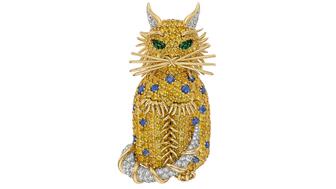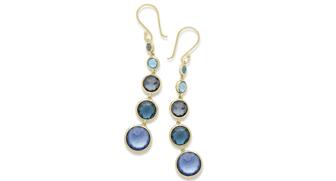The luxury goods company said founder Ippolita Rostagno will remain at the brand’s helm.
Rocks On: ‘Underrated’ iolite on a slow rise
Though iolite is not as well-known as similar gems as supply of fine quality material remains an issue, a slight uptick in demand and its affordability could mean good things for the colored stone.

New York--It is said that iolite dates back to the time of the Vikings, who would use the stone to guide them on their journeys.
Using thin slices of iolite could help them determine the exact location of the sun when they were out exploring, helping them travel safely to the new world and back again.
Despite its long history, the gem, valued for its vivid, saturated hues ranging from violet to blue, is still less well-known than stones like tanzanite and sapphires.
According to the Gemological Institute of America’s Gem Encyclopedia, gem experts believe that this could be because designers and retailers haven’t seen a consistent enough supply in a uniform fine quality to consider investing in large quantities for themselves.
Stuart Robertson, research director for Gemworld International, Inc., said that it’s difference in popularity from tanzanite “really comes down to quality of color. Even in the lighter tones and saturations, tanzanite exhibits a brightness to its color. However, iolite usually doesn’t. It exhibits a color that often has some degree of grey masking it.”
Roger Dery, gem cutter and precision faceter at Spectral Gems, said that quality often also is an issue when he’s looking for iolite. Having been to Africa two to four times a year since 2009, he said that while he does see iolite almost every trip, “frequently it is not of a quality that we can use as a custom faceter.”
The gemstone also has strong pleochroism--which means different colors can be seen depending on the direction that the gem is turned--making it a tricky stone to cut for the best color. This can pose challenges to producers and buyers interested in promoting the gem to retailers as an affordable alternative to other similar stones.
But, iolite has been increasing in use a bit over the past few years and could be slightly on the upswing.
“I believe iolite to be a beautiful gem that is grossly underrated,” Dery said.
An open opportunity
Jewelers who have the ability to do custom pieces often may look for gems that aren’t mainstream to set at the center of these designs, and iolite fits into that category very well.
At the same time, the strong color direction in iolite also can be an obstacle for creativity when it comes to cutting the stone in unique designs. With something like a garnet, where the
However with iolite, due to its unique characteristic, a faceter is lucky to get a 15 percent yield, Dery said.
Yet there remains another area in the chemistry of the stone that could be a positive--it is rarely treated, according to the GIA.
Interestingly, the deep blue hues of some iolite stones are thought to be caused by the same factors that creates the blues in sapphires. Unlike its blue companion, however, iolite can’t be heat treated to help intensify the blue color of the stone since its low melting point won’t allow for the high temperatures needed for the process, the GIA said.
This means that an exceptionally colored iolite likely has the selling point for today’s mindful consumer that it came that way naturally. It also means that pieces that aren’t of fine quality can’t be heat treated to improve their color, limiting supply largely to gem-quality stones that come straight from the earth.
Additionally, iolite is one of the few gemstones that has exceptions when it comes to inclusions and value. Certain types of inclusions in the right orientation can create phenomenal iolite. This is rare and therefore, naturally, coveted by collectors.
One of these is cat’s eye iolite.
The gem also can sometimes contain flat, metallic inclusions, causing a glittery, aventurescent effect in the stone. When the inclusions causing this phenomenon appear in an orange or reddish hue, it can be called “bloodshot” iolite.
Pricing obstacles
In terms of the colored gemstone market, the price of iolite is relatively low, and this affordable price point should help bump its demand.
“Once you get outside of the big three (ruby, sapphire and emerald) and some of the rarities like Paraiba tourmaline, market consumption is not driven by the wealthy, but instead by the middle class,” Robertson said. “This segment is still reactive to price points, which has resulted in a lot of color-substitution based gem purchases in more recent years.”
Dery said that, at trade cost, a dealer can find 3- to 4-carat stones in nicer colors for somewhere in the range of $50 to $75 per carat when it comes from “established cutting centers around the world.” Comparatively, these 3- to 4-carat stones would have sold for about $40 to $55 per carat nearly a decade ago.
North American faceters, however, sell with higher prices because of more exacting standards and a desire for their gems to stand out from the commercial cutting.
Dery said he expects prices to rise another 10 to 15 percent per year in the future.
In his travels to Africa, he said that he has yet to see an iolite mine that had been industrialized. Rather, they are all worked by artisanal miners in groups of anywhere from two to 12.
“These mines are alluvial in nature, and once they hit a certain depth, they are no longer viable to be worked by hand, which will, without any intervention, cause prices to escalate over time.”
In addition to the mining issues that can arise, there also is an increasing interest among a few government mining ministries in Africa to require that gems mined in the country also be cut in the country, instead of exporting the rough at a lower value.
(In 2010, Tanzania implemented such a ban on exporting facetable rough tanzanite weighing more than 1 gram, or roughly 5 carats).
If these movements do come to fruition in the next few years, prices of these gemstones would be greatly affected.
The Latest

Laura Burdese, who joined the Italian luxury brand in 2022, will take on the role in July.

The National Jeweler editors revisit the most noteworthy industry happenings and design trends from 2025.

How Jewelers of America’s 20 Under 40 are leading to ensure a brighter future for the jewelry industry.

Need a gift for the cat lover who has everything? Look no further than our latest Piece of the Week.


It purchased the “Grosse Pièce,” an ultra-complicated Audemars Piguet pocket watch from the ‘20s, for a record-breaking price at Sotheby’s.

The lab-grown diamond grower now offers custom engagement and fashion jewelry through its Kira Custom Lab Jewelry service.

Roseco’s 704-page catalog showcases new lab-grown diamonds, findings, tools & more—available in print or interactive digital editions.

Chandler got his start at Michelson Jewelers and has served as DCA president and CEO since 2001. He will retire at the end of the month.

The boutique is slated to open this week inside Terminal 8, offering pre-owned Rolex watches and more to international travelers.

Sponsored by Digital Monitoring Products

The special-edition egg pendant ingested in a New Zealand jewelry store was recovered after a six-day wait.

Associate Editor Natalie Francisco plays favorites with Piece of the Week, selecting a standout piece of jewelry from each month of 2025.

The “Love and Desire” campaign is inspired by the magic that follows when one’s heart leads the way, said the brand.

Two awardees will receive free tuition for an educational course at the Swiss lab, with flights and lodging included.

Berta de Pablos-Barbier will replace Alexander Lacik at the start of January, two months earlier than expected.

Sotheby’s held its first two jewelry sales at the Breuer building last week, and they totaled nearly $44 million.

Winners will receive free registration and lodging for its fourth annual event in Detroit.

Here are six ideas for making more engaging content for Instagram Reels and TikTok, courtesy of Duvall O’Steen and Jen Cullen Williams.

The honorees include a notable jewelry brand, an industry veteran, and an independent retailer.

Carlos Jose Hernandez and Joshua Zuazo were sentenced to life without the possibility of parole in the 2024 murder of Hussein “Sam” Murray.

Yood will serve alongside Eduard Stefanescu, the sustainability manager for C.Hafner, a precious metals refiner in Germany.

The New Orleans jeweler is also hosting pop-up jewelry boutiques in New York City and Dallas.

Set in a Tiffany & Co. necklace, it sold for $4.2 million, the highest price and price per carat paid for a Paraíba tourmaline at auction.

The jeweler’s “Deep Freeze” display showcases its iconic jewelry designs frozen in a vintage icebox.

Take luxury gifting to new heights this holiday season with the jeweler’s showstopping 12-carat sphene ring.

This year's theme is “Unveiling the Depths of the Ocean.”









































